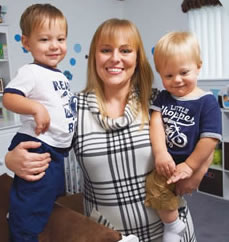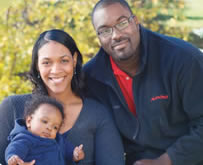The Next Generation

Connect with resources and learn more about how other cancer survivors have coped.
Building a family after cancer
It's a frustrating fact: Preserving fertility for women who face cancer treatments that damage their reproductive organs is much more complicated than it is for men. But the options are slowly expanding for women who would like to build families after treatment.
For years, a myth about young people with cancer has circulated: If you're facing a life-threatening illness, who cares about infertility? But for the nearly 6 million adults of reproductive age who have survived adult or childhood cancer, fertility is a significant factor in preserving quality of life after treatment, says Senait Fisseha, M.D., medical director of the University of Michigan Center for Reproductive Medicine.
The key is to seek out fertility counseling before treatment begins to understand the options, even if the options for women aren't as straightforward as sperm banking, says Marcia Leonard, N.P., who leads the U-M Rogel Cancer Center's Fertility Counseling program.
"I firmly believe that a fertility consult is extremely valuable. As a woman becomes knowledgeable about what's going to happen, she gains some control," Leonard says. "She can learn about her options and then decide if they're in her best interests. Having that knowledge and control makes it a whole different ball game than finding out in 10 years that she's infertile."
Deciding which path to pursue to build a family is a personal choice. We talked with three women to learn how they became mothers after cancer.
Embryo and Egg Preservation

Ewelina Saputo was 23 when she was diagnosed with leukemia. It was a shock, since she hadn't had any symptoms; the cancer was found during a routine blood test at a doctor's appointment. When she learned that the medications she would take in preparation for a bone marrow transplant would likely cause infertility, she asked about her options.
Saputo was a good candidate for embryo preservation because her cancer was caught early, she said. She was taking Gleevec to keep the disease at bay while she waited to find a match for her transplant -- a process that would take nearly seven months.
In the meantime, Saputo got engaged to her then-boyfriend, Dominic, and went through hormone therapy to stimulate her ovaries to produce eggs. The eggs were removed, fertilized with her soon-to-be husband's sperm and frozen. Saputo underwent the bone marrow transplant -- and a 75-day stay in the hospital -- and remains cancer-free today.
In 2009, two years after the Saputos married, two embryos were implanted in Saputo's uterus. Her two sons, Antonio and Julian, were born on June 1, 2010.
"It's amazing and hectic, but it's fun," Saputo says. "I think we were in shock. We couldn't believe we were having twins after everything we went through."
In vitro fertilization remains one of the most reliable means of preserving fertility after cancer treatment, Fisseha says, but many women don't have the option of delaying cancer treatment as long as Saputo did. Until recently, it took four to six weeks to complete the process that would allow a woman's eggs to be harvested; that has been trimmed to two to three weeks, regardless of where a woman is in her cycle. The shortened time frame has helped many women, but it remains an obstacle to those who can't afford to delay cancer treatment due to the aggressive nature or advanced stage of the disease.

Connect with resources and learn more about how other cancer survivors have coped.
In addition, technologies for freezing eggs -- rather than embryos, which are eggs that have been fertilized with sperm -- has vastly improved, Fisseha says. This is a breakthrough for teenagers and women who may not be in committed relationships and don't have a male partner to provide sperm.
However, for some, the cost of egg or embryo preservation is prohibitive: It can range from $16,000 to $18,000 in some cases. But thanks to a partnership with the Livestrong Fertile Hope initiative, the U-M Center for Reproductive Health offers the service to qualified cancer patients for as low as $5,500.
"We don't want money to be the reason patients aren't doing this,"Fisseha says. "It's too important."
OVARIAN SUPPRESSION
For women who cannot wait to begin chemotherapy that may damage their ovaries, a new, experimental option is available. Monthly injections of gonadotropin releasing hormone analog (or GnRHa) are given to women during chemotherapy with the goal of temporarily shutting down the ovaries, Fisseha says.
The approach evolved from the observation that the ovaries in pre-pubescent girls who receive chemotherapy usually do not fail after treatment. Fisseha says researchers think this is because ovaries that are not active are less of a target for damage.
The benefits of GnRHa are not yet definitively proven, Fisseha says, but there is little risk of harm and the treatment is relatively low-cost and often covered by insurance.
"A recent study in the Journal of the American Medical Association showed significant benefits," she says. "It may not be for everybody, but at least some portion of the patient population may benefit."
LeElla Flake may be one of those patients. Flake, a breast cancer patient, received the drug as part of a clinical trial. A year after her ovaries woke up, she became pregnant with her son.
"I didn't focus on the cancer anymore. That didn't scare me. It was 'Oh, I want a baby; what am I going to do about that?'" says Flake of the moment when she learned cancer treatment could impact her fertility. "And so when they brought up the clinical trial I just felt like I could focus on the cancer, because the possibility was back."

ADOPTION
Erin Miller had always expected to adopt a child. Miller was 12 years old when she learned that the abdominal radiation she had received as a 5-year-old for a Wilms' tumor had caused ovarian failure. She had cousins who were adopted, so she was pretty comfortable with the idea of adoption.
But after Miller married her husband, the couple decided to pursue in vitro fertilization using eggs donated by her sister. After three cycles, though, it was clear that Miller's uterus was compromised as a result of radiation therapy and couldn't support a pregnancy.
So in 2002, the Millers embarked on the process of adopting a child. On their first attempt, the birth mother changed her mind. So the Millers waited patiently for another two years. But then a move to Grand Rapids caused them to switch adoption agencies. The very day their paperwork was approved, an expectant teenager chose the Millers to raise her child. The baby -- a girl they named Natalie -- was born three weeks later.
"We had been through the classes and we kind of knew what to expect, but it's sort of a surreal feeling: You're really letting us leave with this baby?" Miller says. "With adoption, you wait, but you never know when that's going to change."
And it may change again for the Millers: The family is seeking to adopt again.
WHO'S AT RISK?
All cancer treatments do not cause infertility, but the therapies or factors listed here increase the risk:
- Patients receiving radiation therapy to the abdomen or pelvis
- Patients receiving alkylating agent chemotherapy or certain other forms of chemotherapy depending on the dose and duration
- Women 30 and older who are receiving cancer treatment
Always talk to your doctor to understand the impact of your treatment on your fertility and other aspects of your life.
